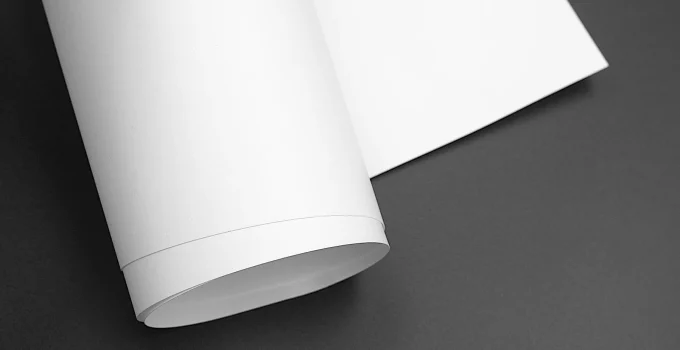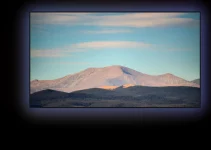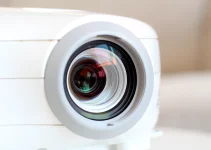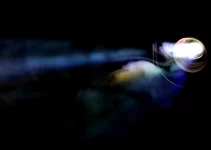Which is the best projector screen material? There are a few different answers that we can offer to this question so let’s quickly go over them and then we can move on to a more in-depth discussion.
If you’re buying your projection screen then you’ll see screens made from vinyl, which are among the best without a doubt.
And you’ll also see polyester screens that are a lot cheaper. If you have a budget under $100, you’ll come across projector screens made from polyester.
On the other hand, some manufacturers don’t mention what materials they’re using. For example, Elite Screens only mentions that they’re using the Elite Screens CineWhite UHD-B as their screen material.
You should consider blackout cloth as a material for projector screens if you are into DIY projects.
Thus, blackout cloth is another very good answer to the question which is the best projector screen material.
Blackout cloth is also used for curtains to block out light and to reduce out-of-room noises at the window.
When it comes to the color of projector screens most of them are going to be white.
Of course, we should also mention that black screens are a thing and some people are more interested in getting a black projector screen rather than a white one.
However, buying a black projector screen is a lot more difficult because white materials are prevalent. Screen Innovations is one brand that focuses on black screens but they’re beyond expensive.
We’ll also talk about using a white sheet as a projector screen or maybe using projector screen paint.
Table of Contents
What is the Best Projector Screen Material? Vinyl Screens
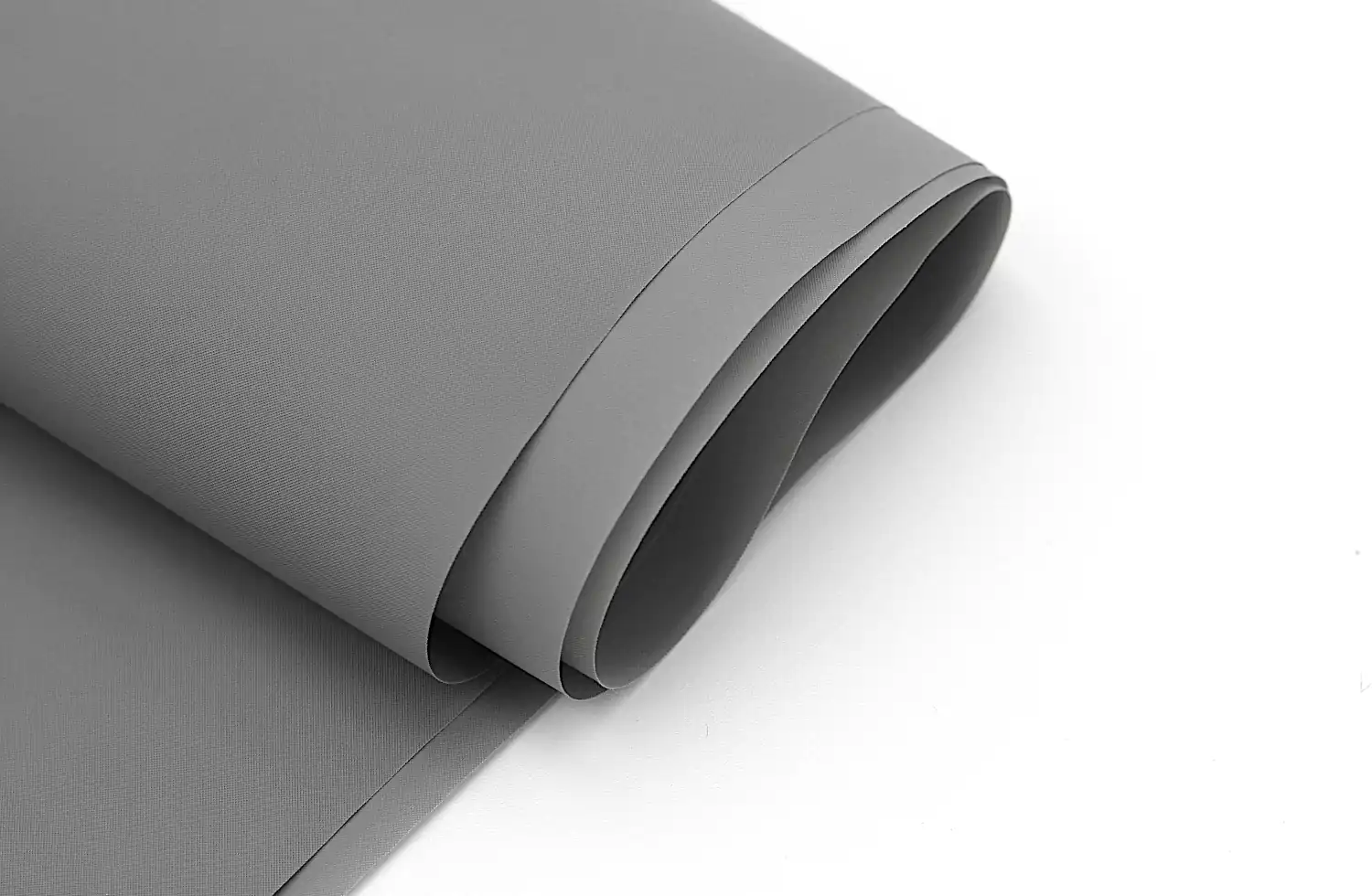
Grey projector screen material
I consider that a white stretchy, high-quality vinyl is the best material for projection screens.
So, if you’re buying your projector screen and you have a very generous budget, then getting a white, high-quality vinyl screen would be awesome.
Silver Ticket is a brand that makes such projectors but they’re not exactly cheap. Still, if you decide to look for the answer to the question of what is the best projector screen material, I have to mention that the screens from Silver Ticket should be at the top of your list.
Silver Ticket actually categorizes their projector screens materials by color: matt white, grey, HC grey, silver, woven acoustic.
All their screens are made from high-quality vinyl but we can get different colors.
The most popular color for projection screens remains white.
Grey is the second most popular choice.
What is truly important is that Silver Ticket promises impressive colors and it also assures us that there is no resolution lost at any angle. That’s what we want from our projector screens.
If we want the best picture quality, we should be prepared to spend quite a bit on a projection screen.
Another thing I like about Silver Ticket screens is that they don’t require tricky installations. The fixed frame screen mounts on the wall pretty much like a large picture frame.
While we should definitely pay attention to the material of the screen, we should also pay attention to the frame that the screen is connected to.
The frames from Silver Ticket are built with durable extruded aluminum. And the aluminum frame is wrapped with a light absorbing black velvet fabric.
What is the Best Projector Screen Material for DIY Screens?
Blackout cloth is among the most popular choices if you’re looking for a material you can use to make your own projector screen.
Blackout cloth might be very familiar to some people because it’s the same material from which curtains/draperies are made.
It is an opaque fabric that is used to black out light. And it also reduces out-of-room noises at the window.
Another interesting aspect is that blackout fabrics are made from polyester or a combination of polyester and cotton.
If you’re looking for a material for DIY projector screens, you’ll most likely end up buying a polyester and cotton fabric blend, coated with layers of thin rubber.
The smooth side reflects light and the foamed side absorbs or blocks light. You’ll project on the smooth side.
A screen made from blackout fabric will work best in a dark room. Ambient light can wash our color but that also happens with bought matt white screens.
As I’ve mentioned in the beginning of this article answering the question which is the best projector screen material, polyester is the prevalent material used for making cheaper projector screens. If you have a budget under $100, polyester screens are what you’ll come across.
There are a lot of YouTube tutorials you can check out. And I also found this article that offers a guide on how to make your own screen at home.
Which blackout cloth should you get?
There are actually blackout cloths that are sold as projector screen materials. Thus, you don’t have to spend too much time trying to figure out which blackout cloth would work best for your DIY projector screen.
The disadvantage with blackout cloths that are sold as projector screen material is that they’re not exactly cheap. While blackout cloth in general is quite cheap, the ones that are sold as projector screen materials are not as cheap as the general ones.
One example of such an option is Carl’s Blackout Cloth. It is described as a budget-friendly, do-it-yourself projector screen building material. I don’t exactly consider it to be very cheap but it’s definitely cheaper than buying a screen from Silver Ticket.
Carl’s Blackout Cloth Projector Screen Material is a matt white surface. It promises to diffuse light in all directions so the image can be seen from any angle.
It also promises to provide accurate color and clarity when ambient light is controlled. As always, we can expect that projectors are better used in dark rooms but there are also projectors for daylight for those who want to watch content in ambient light.
In order to make your own projector screen from blackout cloth you’ll also need a fixed frame because this material needs to be stretched evenly to a frame in all four directions.
I also recommend using black felt tape if you want to make a nice border for your screen.
Which color screen should you choose?
We’ve talked about projector screen materials both if we want to buy our screen or if we want to make our own. I also mentioned from time to time the color that these materials have.
I actually mentioned three colors: matt white, grey, and black.
Matt white
Matt white still remains the most popular color for screens, whether they’re bought or made at home from blackout cloth.
White screens were the first on the market. For a very long time they were the only option. And they have remained the most popular. But that’s to be expected.
Grey and black screens are becoming more and more popular because they’re considered to be better than matt white.
However, the problem is not in the fact that they’re better. It’s in their price and the face that they’re harder to find.
Overall, matt white screens remain the most affordable and that’s what still makes them the most popular on the market.
White screens reflect light well and they don’t alter the projected image.
They also perform best in dark rooms or in dark environments, in case you’re using your projector for camping.
Grey
Silver Ticket, which is among the best brands for projector screens that are expensive but don’t cost a fortune, makes both matt white and grey screens.
Their grey screens are a little bit more expensive than the matt white ones.
Silver Ticket mentions that their grey screens are designed for setups with some uncontrolled lighting and/or background lighting.
Thus, if you want to enjoy your projector in ambient light, grey screens can be a bit better than the matt white ones.
Black
Just as their color suggests, black screens are the best at reproducing the darker portions of an image. It means that they’re perfect for achieving the best contrast ratio.
The important thing to know about black screens is that they’re the perfect choice for those who project in ambient light in their bedroom or living room or outdoors, etc.
Screen Innovations is a brand that makes black projection screens, using their Black Diamond material. The claim is that their Black Diamond material makes it possible to use a front projector with the lights on. However, the prices of their screens doesn’t allow a lot of people to actually enjoy their products.
If you have a projector under $300 or $1,000 or something in that range, you’re not going to think of black projector screens as the best option for you.
Why use a screen?
Simply put, a high-quality projector screen is the essential component that displays what our projectors are capable of.
A good screen will properly display our projector’s brightness and it will display the range of colors our device is capable of. If we want the best overall image quality, we’re going to need a screen.
It’s important to answer a question like this one addressing what is the best projector screen material but it’s also important to know if you want to buy your screen or if you want to do it yourself from blackout cloth or some kind of other fabric.
We also have the option of painting a wall with projector screen paint. I’ll be honest, this is my least different option.
Overall, I believe that your budget is among the most important factors that is going to influence which screen you’ll buy.
And, if you want to keep the price as low as it can possibly get, you’ll maybe choose to make your own projection screen from blackout cloth.
Using projector screen paint is absolutely not the cheapest option. DIY projector screens remain the cheapest option.
And if you don’t want to spend any money at all you’re just going to project directly on a wall. I wouldn’t recommend it because the overall image quality is degraded considerably but projecting on a wall is always going to be an option for those who don’t want to spend money on a screen.
Check out my reviews for the best 4K projector screens if you want to find amazing screens for your projector, whether you’re using a device with HD, Full HD or 4K resolution.
Should you use projector screen paint?
You can consider it if you find some projector screen paint at a reasonable price. Among the cheapest options is the Behr Silver Screen paint.
Some are quite expensive and you need to apply two coats. But once you apply the two coats you can always use the wall to project your content on it.
I should mention that I remain old-school so I’m going to stick to my projector screen.
But maybe some people are going to be interested in just painting a wall and then projecting directly on that painted wall instead of dealing with installing a projecting screen and dealing with the material and everything that comes with it.
Can we use a white sheet as a projector screen?
Since we’re talking about materials for projector screens, we should also figure out if we can use a simple white sheet to project on it.
Well, it’s not the best option but it can maybe work better than a naked wall.
My advice is to use a white, thick sheet if you’re going to use a sheet as a projector screen.
Of course, you’ll have to smooth out any folds. Folds can also be a nuisance if we’re buying a cheap projector screen so it’s not a con just for white sheets.
However, getting a thick sheet is crucial because a thin sheet will let the light pass through it.
Thick sheets have the chance to keep the light on them.
The alternative to using a thick sheet is to layer a bunch of thin sheets until they’re thick enough to prevent the light from passing through.
All in all, the answer to the question of what is the best projector screen material depends on your budget and which option would work best for you because there are plenty of options to choose from.

